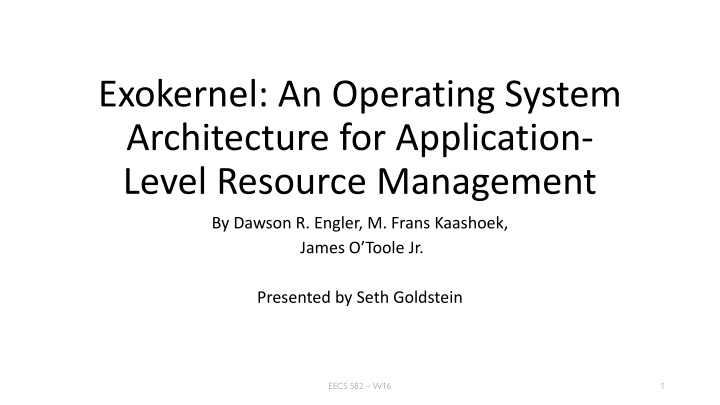
Exokernel: Application-Level Resource Management Architecture
"Learn about Exokernel - an innovative operating system architecture for application-level resource management, contrasting with traditional OS designs. Explore its benefits, hypotheses, and comparison with library OS. Presented in slides for EECS 582 course."
Download Presentation

Please find below an Image/Link to download the presentation.
The content on the website is provided AS IS for your information and personal use only. It may not be sold, licensed, or shared on other websites without obtaining consent from the author. If you encounter any issues during the download, it is possible that the publisher has removed the file from their server.
You are allowed to download the files provided on this website for personal or commercial use, subject to the condition that they are used lawfully. All files are the property of their respective owners.
The content on the website is provided AS IS for your information and personal use only. It may not be sold, licensed, or shared on other websites without obtaining consent from the author.
E N D
Presentation Transcript
Exokernel: An Operating System Architecture for Application- Level Resource Management By Dawson R. Engler, M. Frans Kaashoek, James O Toole Jr. Presented by Seth Goldstein EECS 582 W16 1
Outline Traditional Operating System Exokernel Implmentation Kernel Comparisons Conclusion EECS 582 W16 2
Outline Traditional Operating System Exokernel Implmentation Kernel Comparisons Conclusion EECS 582 W16 3
Traditional Operating System Centralized resource management All applications must use the same abstractions High-level abstractions Overly general Provide all features possible Implementation cannot be modified Limited functionality Information is hidden EECS 582 W16 4
Outline Traditional Operating System Exokernel Implmentation Kernel Comparisons Conclusion EECS 582 W16 5
Exokernel and Library Operating Systems Implement traditional abstractions at the user-level EECS 582 W16 6
Hypotheses Exokernels can be very efficient Low-level, secure multiplexing of hardware resources can be implemented efficiently Traditional operating system abstractions can be implemented efficiently at application level Applications can create special-purpose implementations of these abstractions EECS 582 W16 7
Library Operating Systems Simpler Specialized Multiple can exist Few Kernel crossings EECS 582 W16 8
Exokernel Design Avoid resource management Allow the request of specific resources Visible resource revocation Secure bindings Downloading code Abort protocol Extendable EECS 582 W16 9
Outline Traditional Operating System Exokernel Implmentation Kernel Comparisons Conclusion EECS 582 W16 10
Aegis Scheduling Processor events Exceptions Protected Control Transfers Time to perform null procedure and system call ( s) Exception dispatch time ( s) EECS 582 W16 11
ExOS: Interprocess Communication (IPC) IPC time EECS 582 W16 12
ExOS: Virtual Memory Virtual memory operations ( s) EECS 582 W16 13
ExOS: Application-Specific Safe Handlers (ASH) Roundtrip Latency vs Number of Processes 60-byte roundtrip latency over Ethernet ( s) EECS 582 W16 14
Outline Traditional Operating System Exokernel Implmentation Kernel Comparisons Conclusion EECS 582 W16 15
Kernel Comparisons Exokernel Multikernel EECS 582 W16 16
Other Related Systems NanoKernel Virtual Machines EECS 582 W16 17
Outline Traditional Operating System Exokernel Implmentation Kernel Comparisons Conclusion EECS 582 W16 18
Conclusion Exokernels can be very efficient The lower the level of a primitive the more efficient it is EECS 582 W16 19
Questions and Discussion EECS 582 W16 20
References http://web.eecs.umich.edu/~mosharaf/Readings/Exokernel.pdf http://web.eecs.umich.edu/~mosharaf/Readings/Multikernel.pdf https://www.cs.utexas.edu/~dahlin/Classes/GradOS/papers/kaashoek97sosp.pdf https://thelinuxdesk.wordpress.com/tag/monolithic-kernel/ https://en.wikipedia.org/wiki/Monolithic_kernel#/media/File:OS-structure2.svg EECS 582 W16 21
